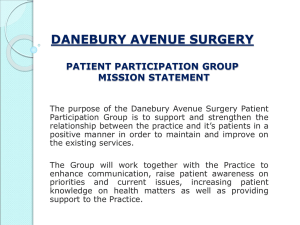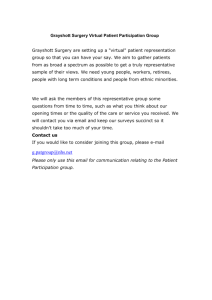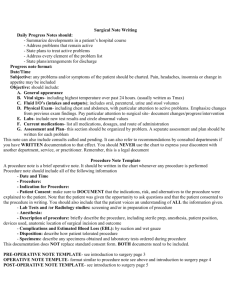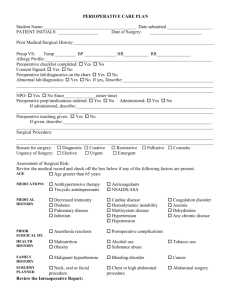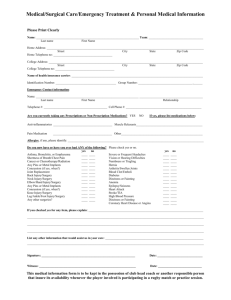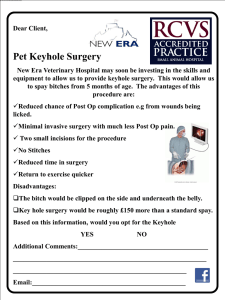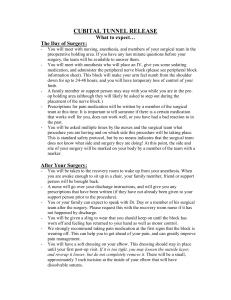Guidance on pre-operative fasting in healthy adults
advertisement
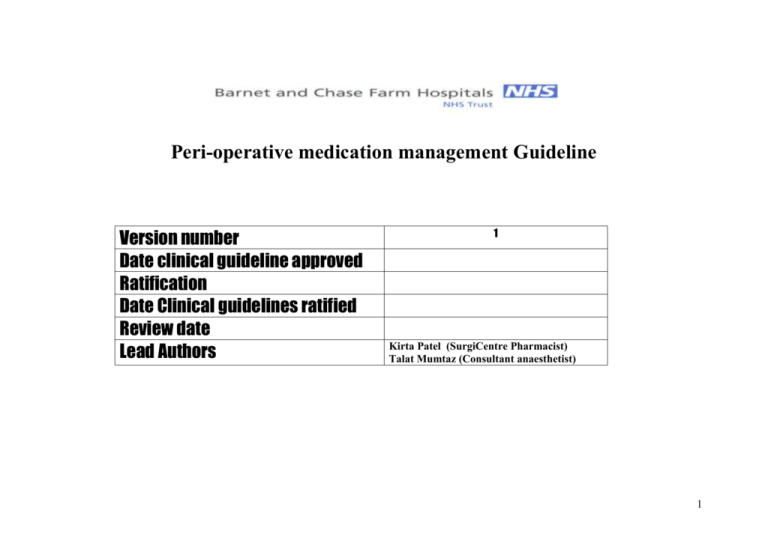
Peri-operative medication management Guideline Version number Date clinical guideline approved Ratification Date Clinical guidelines ratified Review date Lead Authors 1 Kirta Patel (SurgiCentre Pharmacist) Talat Mumtaz (Consultant anaesthetist) 1 Peri-operative medication management Guideline Many patients presenting for surgery will be on medication for the management of concurrent diseases. The decision to discontinue, or accidentally omit, medication preoperatively can cause exacerbation of the underlying disease or it can precipitate an acute withdrawal syndrome. On the other hand, continuing routine medication perioperatively may have potentially fatal interactions with some anaesthetics used during surgery. The following is therefore intended as a guide to indicate which drugs should be continued and which drugs should be stopped in the peri-operative period for patients that will be undergoing all elective surgery. It is NOT a protocol and where there is any doubt about peri-operative medication, advice should be sought from the anaesthetist, haematologist, cardiologist or a member of the surgical team. Specific instructions given on the management of individual drugs should be followed. When changing the route of administration of a drug care should be taken to ensure that the appropriate dose and frequency is prescribed, as they may not be the same as for the oral route. Contact Medicines Information (ext 1486). The classification of this guideline is based on BNF categories (e.g. omeprazole can be found under the Gastro-intestinal system). Guidance on pre-operative fasting in healthy adults Intake of water up to two hours before induction of anaesthesia for elective surgery is safe in healthy adults, and improves patient wellbeing. Tea and coffee with milk are acceptable up to six hours before induction of anaesthesia. The volume of administered fluids does not appear to have an impact on patients’ residual gastric volume and gastric pH, when compared to a standard fasting regimen. A minimum preoperative fasting time of six hours is recommended for food (solids and milk). Chewing gum should not be permitted on the day of surgery. Sweets are solid food, and can be taken up to six hours before induction of anaesthesia. Regular medication considered appropriate to be taken pre-operatively (e.g. antihypertensive drugs except ACE-inhibitors and angiotensin-2-antagonist) should be taken up to 2 hours before surgery unless contra-indicated. Clinical Practice Guidelines. Perioperative fasting in adults and children. Royal College of Nursing; London 2005 . 2 GENERAL RULE: DO NOT STOP ANALGESIA, ANTIEPILEPTICS, BRONCHODILATORS, SOME CARDIOVASCULAR DRUGS, GLAUCOMA DRUGS, THYROID OR ANTI-THYROID DRUGS AND PEPTIC ULCER DRUGS PRIOR TO SURGERY. STOP HERBAL MEDICATIONS 2 WEEKS BEFORE SURGERY. FOR DRUGS NOT INCLUDED IN THE TABLE BELOW CONTACT MEDICAL INFORMATION (EXT 1486). BNF 1. Gastro-intestinal system BNF Classification Examples Risk Recommendation Antacids Gaviscon Risk of acid aspiration if stopped Antispasmodics Antimuscarinics Mebeverine Hyoscine butylbromide Dicycloverine hydrochloride Risk of paralytic ileus Risk of paralytic ileus Consider ranitidine if patient has symptomatic acid reflux (see PGD‘Ranitidine for patients undergoing surgery who are at high risk of reflux’) Omit on the morning of the operation Omit on the morning of the operation IV/IM Hyoscine butylbromide H2-receptor antagonists Rantidine Cimetidine Lansoprazole Omeprazole Pantoprazole Esomeprazole Mesalazine Balsalazide Sulfasalazine Senna Sodium docusate Lactulose Reduces the risk of acid aspiration Reduces the risk of acid aspiration Continue IV ranitidine Continue. If the patient takes this on a when required basis inform them to take a dose on the morning of the operation. Continue IV ranitidine Proton pump inhibitors Aminosalicyclates Laxatives Fybogel Adequate fluid intake needs to maintained to avoid intestinal obstruction. Alternative post-op if unable to take orally. Omit morning dose Phosphate enema Glycerol suppositories Omit morning dose 3 BNF 2.Cardiovascular system BNF Classification Examples Risk Recommendation Cardiac glycosides Digoxin Risks of arrhythmias, embolism, cardiac failure poor tissue healing if omitted. Risk of ventricular arrhythmias when given with suxamethonium. Continue Thiazides and related diuretics Loop diuretics Bendrofluamethiazide Indapamide Furosemide Bumetanide Potassium sparing diuretics and aldosterone antagonists Amiloride Spironolactone Anti-arrhythmic drugs Amiodarone Flecainide Atenolol Bisoprolol Carvedilol Celiprolol Labetalol Metoprolol Hydralazine Minoxidil Beta-blockers Vasodilator Centrally acting antihypertensive Clonidine Methyldopa Moxonidine Nebivolol Oxprenolol Pindolol Propranolol Sotalol Timolol Alternative post-op if unable to take orally. 100mcg IV digoxin = 125mcg oral digoxin tablets. Liquid 50mcg digoxin =62.5mcg tablets Continue Continue Tissue damage and reduced kidney perfusion in immediate post-op period can lead to hyperkalaemia. Reduces the risk of perioperative arrhythmias. Risk of withdrawal syndromerebound tachycardia, angina, acute coronary syndrome, arrhythmias if omitted. Continue Risk of hypertension, tachycardia, MI and stroke if omitted. Continue to avoid rebound symptoms and hypertensive crisis. Continue Continue Continue IV diuretics Max IV rate for furosemide=4mg/minute Use IV alternative within the same class Give alternative IV betablocker (e.g. Labetalol) IV alternatives available Continue 4 BNF 2. Cardiovascular system (Continued) BNF Classification Examples Risk Recommendation ACE-inhibitors Captopril Perindopril Cilazapril Quinalapril Enalapril Ramipril Fosinopril Trandolapril Imidapril Moexipril Lisinopril Candesartan Olmesartan Eprosartan Telmisartan Irbesartan Valsartan Losartan Doxazosin Terazosin Isosorbide mononitrate Isosorbide dinitrate Risk of hypotension, renal failure, and reduced cerebral blood flow. Omit morning dose Risk of hypotension and renal failure Omit morning dose Use alternative IV antihypertensive agent Hypotension Continue- improves cardiovascular stability Continue Use alternative IV antihypertensive agent Topical (patches), buccal, sublingual and IV forms available. Amlodipine Diltiazem Felodipine Verapamil Nicorandil Hypotension Bradycardia (verapamil) Risk of angina, acute coronary syndrome if omitted. Hypotension Continue Cilostazol Contraindicated in those that have had surgery in the previous 3 months (predisposition to bleeding) Consult with surgical/vascular team. Manufacturers suggest stopping 2-3 days prior to surgery and restarting 3 months after the operation. Angiotensin-II receptor antagonist Alpha blockers Nitrates Calcium-channel blockers Potassium-channel activator Peripheral vasodilator Hypotension. Risk of angina, acute coronary syndrome if omitted. Omit morning dose Alternative post-op if unable to take orally. Use alternative IV antihypertensive agent Alternative anti-anginals (see nitrates) 5 BNF 2. Cardiovascular system (Continued) BNF Classification Examples Risk Recommendation Aspirin Haemorrhagic risk Clopidogrel Haemorrhagic risk Dipyridamole Haemorrhagic risk It is advisable to stop 7 days prior to surgery especially for patients that are likely to bleed but please confirm with surgeon as it may depend on type of surgery, and surgeon’s preference. Also please be aware of the highrisk patient (e.g. vascular/TIA/stroke) in whom it may be advisable to continue. Please confirm with surgical team in charge. Seek advice from cardiologist/ surgical team for all cases, unless the patient is on it for intolerance to aspirin in which case it needs to be stopped 7 days prior to surgery. Please confirm with surgical team in charge. Seek advice from surgical team for all cases. Anticoagulants Warfarin Haemorrhagic risk Statins Atorvastatin Pravastatin Rosuvastatin Simvastatin Antiplatelet drugs See ‘Guidelines for the management of anti-coagulation in the perioperative period for elective surgery’. Continue Alternative post-op if unable to take orally. The surgical team should decide when the patient should be restarted postoperatively. 6 BNF 3. Respiratory BNF Classification Examples Beta-2 antagonist Salbuatmol Terbutaline Salmetrol Ipratropium bromide Tiotropium Continue Theophylline Theophylline Aminophylline Continue Corticosteroids Beclometasone Fluticasone Budesonide Montelukast Zafirlukast Carbocysteine Mecysteine Continue Antimuscarinic brochodilators Leukotriene receptor antagonists Mucolytics Risk Recommendation Continue Alternative post-op if unable to take orally. May need to substitute with nebulised therapy perioperatively. May need to substitute with nebulised therapy perioperatively. Consider aminophylline infusion in patients nil by mouth. Monitor levels closely. May need to substitute with nebulised therapy perioperatively. Continue Continue 7 BNF 4. Central Nervous System BNF Classification Examples Risk Recommendation Hypnotics and anxiolytics Abrupt withdrawal may cause confusion, toxic psychosis, convulsions and withdrawal syndromes. Continue Antipsychotic Diazepam Nitrazepam Temazepam Chlorpromazine Haloperidol Clozapine Risk of acute withdrawal symptoms or relapse. Risk of arrhythmias. Associated with thromboembolism Risk of withdrawal symptoms Can lower seizure threshold. Antimanic drugs Lithium Abrupt discontinuation of lithium increases the risk of relapse. Lithium may prolong the effects of neuromuscular blocking agents. Monitor renal function, fluid and electrolyte function post-operatively. Continue. Discuss with patients psychiatrist if concerned. Discuss with psychiatrist before stopping. If it is considered appropriate to stop, it should be stopped 12 hours before surgery. Patient should receive the next dose after surgery at the usual time and at full dose if the patients vital signs are stable. If clozapine is discontinued for more than 48 hours it must be re-titrated beginning at the 12.5mg dose. Continue but discuss with psychiatrist if concerned. Antipsychotic drugs Tricyclic antidepressants SSRIs Antidepressants Amitriptyline Clomipramine Dosulepin Imipramine Nortriptyline Fluoxetine Citalopram Escitalopram Paroxetine Risk of withdrawal symptoms. Increase effect of exogenous catecholamines e.g. adrenaline resulting in arrhythmia. SSRIs can interact with drugs such as tramadol and pethidine (which block presynaptic uptake of serotonin), to precipitate ‘serotonin syndrome’, which can be fatal. Alternative post-op if unable to take orally. U&Es and lithium level must be checked pre-operatively. Ensure adequate fluid intake during and after surgery. Continue Continue 8 BNF 4. Central Nervous System (continued) BNF Classification Irreversible MAOIs antidepressants Examples Risk Recommendation Phenelzine Isocarboxazid Tranylcypromine Consult with psychiatrist/ anaesthetist Reversible MAOI antidepressant Moclobemide Centrally acting appetite suppressants Sibutramine CNS excitation and depression when given with pethidine/ opioid analgesics- avoid concomitant use and for 2 weeks after stopping MAOI. Risk of hypertensive crisis when given with sympathomimetics. Hazardous interactions between MAOIs and general anaesthetics. Risk of hypertensive crisis when given with sympathomimetics. Possible CNS excitation and depression when given with pethidine avoid concomitant use. Possible CNS excitation and depression when given with opioid analgesics. Predisposition to bleeding. Concomitant drugs that increase risk of bleeding should be used with caution e.g. aspirin, NSAIDs. Serotonin syndrome may occur with certain opioids. Non-opioid analgesics Opioid analgesics Paracetamol Nefopam Fentanyl Morphine Buprenorphine Phenytoin Sodium Valproate Carbamazepine Anti-epileptic drugs Alternative post-op if unable to take orally. Omit on the day of surgery, only after discussing with psychiatrist. Continue Continue Risk of withdrawal symptoms if withdrawn suddenly. Discuss with pain consultant Abrupt withdrawal should be avoided as it may precipitate severe rebound seizures. Continue Carbamazepine 100mg tabletsCarbamazepine 125mg suppositories. Sodium Valproate IV Sodium Valproate Oral Phenytoin 100mg tablets/capsules= Phenytoin 90mg liquid. Phenytoin IV dose is equivalent to tablets/capsules. 9 BNF 4. Central Nervous System (continued) BNF Classification Drugs for Parkinson’s disease Examples Risk Recommendation Levodopa with dopadecarboxylase inhibitors: Co-careldopa Co-beneldopa Dopamine receptor agonists: Apomorphine Pergolide Bromocriptine Pramipexole Cabergoline Roprinirole Lisuride Rotigotine Avoid abrupt withdrawal it may worsen parkinsonian symptoms Continue Avoid abrupt withdrawal. Continue COMP inhibitors: Entacapone Tolcapone MAO-B inhibitors: Selegiline Rasagiline Antimuscarinic drugs used in parkinson’s disease: Benzhexol (Trihexyphenidyl) Orphenadrin Drugs for dementia Acetylcholinesterase inhibitors: Donepezil Galantamine Rivastigmine NMDA-receptor antagonist: Memantine Alternative post-op if unable to take orally. Avoid concomitant use with metoclopramide. Risk of toxicity when bromocriptone is given with isometheptene or phenylpropanolamine. Entacapone possibly enhances effects of adrenaline (epinephrine), dobutamine, dopamine and noradrenaline (norepinephrine). Hyperpyrexia and CNS toxicity reported when given with pethidine (avoid concomitant use). Avoid concomitant use with sympathomimetics. Avoid abrupt withdrawal. Antimuscarinics antagonise the effects of metoclopramide on gastrointestinal activity. Avoid metoclopramide. Donepezil possibly enhances the effects of suxamethonium. Galantamine, rivastigmine enhance the effects of suxamethonium. Donepezil possibly antagonises the effects of nondepolarising muscle relaxants. Rivastigmine enhances the effect of non-depolarising muscle relaxants. Increased risk of CNS toxicity when given with ketamine. Manufacturer recommends avoid concomitant use. Continue Continue Continue Continue Continue 10 BNF 6. Endocrine system BNF Classification Examples Risk Recommendation Insulin Risk of hypoglycaemia in fasted patients. Risk of hypoglycaemia in fasted patients. See Pre-admission protocol. Increased risk of acidosis See Pre-admission protocol. Consider sliding scale insulin. Can delay digestion and absorption of sucrose and starch therefore restart once patient resumes normal diet. Risk of hypoglycaemia in fasted patients. Risk of hypoglycaemia in fasted patients. See Pre-admission protocol. Consider sliding scale insulin. See Pre-admission protocol. Consider sliding scale insulin. Consider sliding scale insulin. Sulphonylureas: Gliclazide Glibenclamide Glimepiride Glipizide Biguanides: Metformin See Pre-admission protocol. Alternative post-op if unable to take orally. Consider sliding scale insulin. Consider sliding scale insulin. Drugs for diabetes Acarbose Nateglinide Repaglinide Thiazolidinediones: Pioglitazone Rosiglitazone See Pre-admission protocol. 11 BNF 6. Endocrine system (continued) BNF Classification Examples Thyroid hormones Levothyroxine liothyronine Carbimazole, Propylthiouracil Prednisolone Dexametasone Fludrocortisone Hydrocortisone Antithyroid drugs Corticosteroids Female sex hormones (combined or oestrogen-only HRT) Female sex hormones (progesterone only) Premique Prempak Premarin Risk Recommendation Alternative post-op if unable to take orally. Continue Continue Abrupt withdrawal may precipitate acute adrenal insufficiency Risk of venous thromboembolism No increased risk of venous thromboembolism. Continue May need to supplement dose peri-operatively. Ensure current and past steroid use is documented. Continue Patients with a family history/ previous history of DVT/PE/haematological blood disorder should be referred to the surgical team. Continue 12 BNF 6. Endocrine system (continued) BNF Classification Examples Risk Recommendation Other female sex hormones Raloxifene Risk for venous thrombo-embolic events that is similar to the reported risk associated with current use of hormone replacement therapy. Anti-androgens Cyproterone acetate Thromboembolic events have been reported in patients using cyproterone. Patients with previous arterial or venous thrombotic / thromboembolic events (e.g. deep vein thrombosis, pulmonary embolism, myocardial infarction), with a history of cerebrovascular accidents or with advanced malignancies are at increased risk of further thromboembolic events, and may be at risk of recurrence of the disease during cyproterone therapy. Discontinuation should happen from three days before the immobilisation occurs. Therapy should not be restarted until the initiating condition has resolved and the patient is fully mobile. Consult with haematology if patient is high risk otherwise continue. Alternative post-op if unable to take orally. 13 BNF 6. Endocrine system (continued) BNF Classification Examples 5 reductase inhibitor Finasteride Dutasteride Desmopressin Posterior pituitary hormone Biphosphonates and other drugs affecting bone metabolism Risk Recommendation Alternative post-op if unable to take orally. Continue If and when to stop desmopressin will depend on the indication for desmopressin and whether fluids will be administered to the patient. Alendronate Etidronate Risedronate Needs to be taken with a full glass of water. Restart when patient is able to comply with recommendations. Strontium In phase III placebo-controlled studies, strontium ranelate treatment was associated with an increase in the annual incidence of venous thromboembolism (VTE), including pulmonary embolism. Ensure adequate preventative measures are taken post-operatively. If desmopressin is being used for haemostatic indications it should be continued. For primary nocturnal enuresis if no fluids are required during/ after surgery desmopressin can be taken as normal. If fluids are required, to minimize fluid retention desmopressin should not be taken on the night prior to surgery. Omit on the morning of the operation Consult with haematology if patient is high risk otherwise continue. 14 BNF 7. Obstetrics, gynaecology and urinary-tract disorders BNF Classification Examples Risk Recommendation Combined hormonal contraception Microgynon Loestrin Marvelon Increased risk of venous thromboembolism Drugs for urinary retention Alfuzosin Tamsulosin The administration of general anaesthetics to patients receiving alfuzosin can cause profound hypotension. There is a theoretical risk of enhanced hypotensive effect when tamsulosin is given with anaesthetic agents. Consider stopping 4 weeks before for varicose vein patients belonging to Barnet site. Give contraceptive advice. Patients with a family history/ previous history of DVT/PE/haematological blood disorder should be referred to the surgical team. Withdraw alfuzosin 24 hours before surgery. Drugs for urinary incontinence Oxybutynin Tolterodine Alternative post-op if unable to take orally. Continue 15 BNF 8. Malignant disease and immunosuppression BNF Classification Examples Risk Recommendation Hormone antagonists Oestrogen receptor antagonist (e.g. Tamoxifen) Increased risk of thromboembolic event. A 2-3-fold increase in the risk for VTE has been demonstrated in healthy tamoxifen-treated women. For patients being treated for infertility, tamoxifen should be stopped at least 6 weeks before surgery or long-term immobility (when possible) and re-started only when the patient is fully mobile. Surgery and immobility: Tamoxifen treatment should only be stopped if the risk of tamoxifeninduced thrombosis clearly outweighs the risks associated with interrupting treatment. All patients should receive appropriate thrombosis prophylactic measures. Alternative post-op if unable to take orally. For patients with breast cancer discuss with surgical team and oncology team. Patient should be advised to report sudden breathlessness and any pain in the calf of one leg, Aromatase inhibitors Anti-androgen (Gonadorelin analogues) Anastrazole Letrozole Exemestane Bicalutamide Flutamide (see above for cyproterone acetate) Continue Continue 16 BNF 10. Musculoskeletal and joint diseases BNF Classification Examples Risk Recommendation Ibuprofen Diclofenac Etodolac Indometacin Meloxicam Naproxen Nabumetone Non selective NSAIDs inhibit COX-1 which Selective inhibitors of COX-2: Celecoxib Etoricoxib Lumiracoxib Penicillamine Does not inhibit COX-1 therefore platelet Consider stopping for procedures with a high risk of bleeding e.g. revision of a joint and back surgery. Please confirm with surgeon. Stop ibuprofen, mefenamic acid, diclofenac, indometacin the day before surgery. Stop naproxen and etodolac 3 days before the surgery. Stop nabumetone and meloxicam 5 days before surgery. Continue blocks the formation of thromboxane A2, resulting in thromboxane-dependent aggregation which prolongs bleeding. NSAIDs Drugs suppressing the rheumatic disease process Cytokine inhibitors Gout Skeletal muscle relaxants Hydroxychloroquine Azathioprine Leflunomide Sulfasalazine Etanercept Infliximab Adalimumab Anakinra Allopurinol Baclofen, dantrolene Alternative post-op if unable to take orally. aggregation is not affected. Potential for disruption of collagen synthesis and delay in wound healing. Continue May delay wound healing May affect wound healing Continue Consult with surgical team Consult with surgical team Continue May increase the risk of infection or healing complications. Consult with surgical team Serious side-effects can occur on abrupt Continue Continue withdrawal 17 Herbal Medication Herb Echinacea Ephedra Garlic Gingko Ginseng Kava St John’s Wort Valerian Risk Allergic reactions Reduced effectiveness of immunosuppressive drugs Impaired wound healing Increased risk of infection Risk of MI and stroke with halothane Ventricular arrhythmias Haemorrhagic risk especially in combination with other anti-platelet drugs. Haemorrhagic risk especially in combination with other anti-platelet drugs. Hypoglycaemia Haemorrhagic risk Decreased anticoagulative effect of warfarin. Possible increase sedation with anaesthetics. Interaction with a number of drugs including warfarin and steroids Increased sedative effect with anaesthetics. Withdrawal symptoms may develop during post-operative period, which can be treated with benzodiazepines. Recommendation Stop all herbal medications 2 weeks prior to surgery 18
